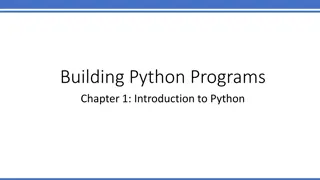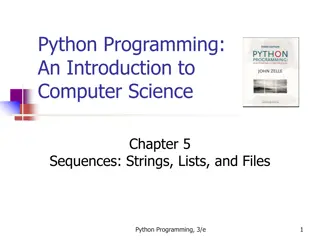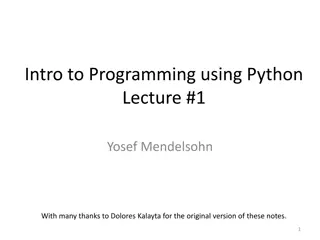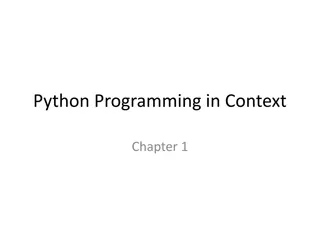Python Programming Techniques at Princeton Institute for Computational Science and Engineering
Delve into the world of Python programming techniques taught by Eliot Feibush at PICSciE, the Princeton Institute for Computational Science and Engineering. Learn about variable declaration, memory allocation, interpreting code, and the convenience of running Python code directly without compiling. Explore the power of Python with examples, teaching assistants, interpreters, and the Integrated Development Environment (IDLE). Uncover the magic of arithmetic expressions, variables, strings, lists, and more, and see how Python simplifies the process with its interpreter and interactive shell.
Download Presentation

Please find below an Image/Link to download the presentation.
The content on the website is provided AS IS for your information and personal use only. It may not be sold, licensed, or shared on other websites without obtaining consent from the author.If you encounter any issues during the download, it is possible that the publisher has removed the file from their server.
You are allowed to download the files provided on this website for personal or commercial use, subject to the condition that they are used lawfully. All files are the property of their respective owners.
The content on the website is provided AS IS for your information and personal use only. It may not be sold, licensed, or shared on other websites without obtaining consent from the author.
E N D
Presentation Transcript
Python Programming Techniques Eliot Feibush PICSciE Princeton Institute for Computational Science and Engineering
Teaching Assistants Shaantam Chawla Mollie Bakal Angad Singh
sample1.py x = 0. xmax = 2. xincr = .1 while x < xmax: # Here is a block of code y = x * x print(x, y) x += xincr
sample2.py s = shrubbery print (s) print (type(s) ) print (len(s) )
Example No variable declaration. No memory allocation. No compiling, no .o or .obj files No linking. No kidding - Just run.
python Runs your program python sample1.py sample1.py source code is run directly instead of compile, link, run No .obj nor .o files of compiled code No .exe nor a.out of executable code
Interpreter Everything that a program can have: Arithmetic expressions Variables Strings Lists import math
help() dir() type() >>> help() # interpretor help> keywords # if, else, for help> symbols help> modules # + - = / # math, os, sys help> topics# USE UPPER CASE Python Rosetta Stone
Try out the interpreter $ python >>> 2+3 5 >>> a = 5.1 >>> b = 6.2 >>> print (a*b) 31.62
Mac Magnifying glass: idle Python 2.7 IDLE (Python GUI) ______________________________________ Windows Start Menu Python IDLE (Python GUI)
Variables Case sensitive Start with a letter, not a number Long names OK
Types and Operators int float long complex # scalar variable, holds a single value a = (3 + 4j) # type(a) + - * / % // ** # Arithmetic operators += -= *= /= # Assignment operators < <= > >= == != # Comparison operators + # has magic overload abilities!
Casts int() long() float() hex() # string representation oct() # string representation str() # for printing numbers + strings
Built-in Constants True <type bool > False <type bool > None <type NoneType >
Indenting Counts! Indent 4 spaces or a tab -- be consistent : at end of line indicates start of code block requires next line to be indented Code block ends with an outdent Code runs but not as desired check your indents
Program Loops Conditionals, Control Functions
Keywords Control if else elif while break continue and or not >>> help() help > keywords
idle: File New Window Save ctrl-s Run Run Module F5
idle IDE Color-coded syntax Statement completion Written in Python with tkinter GUI module.
Programming Exercise Write a python program that converts degrees to radians for: 0, 10, 20, 30, ... 180 degrees edit and save: deg.py Run F5: deg.py radians = degrees * pi / 180. print(degrees, radians)
Debugging Tip IDLE shell retains variables in scope after running program: dir() print(degree) python -i exdeg.py
Comments in line text after # is ignored # can be in any column This is a multi-line comment that will be compiled to a string but will not execute anything. It is code so it must conform to indenting Text within triple quotes
Strings Sequence of characters such as s = abcdefg Indexed with [ ] starting at [0] s[ -1 ] refers to last character in string. Negative indexing starts at last character. Use s[p:q] for string slicing. s[3:] evaluated as defg s[:3] evaluated as abc up to but not 3 s[1:-2] evaluated as bcde up to but not including -2
String Concatenation first = John last = Cleese full = first + + last sp = full = first + sp + last
+ Operator is Operand Aware >>> water + fall # concatenate >>> 3 + 5 # addition >>> 3 + George # unsupported type >>> George + 3 # cannot concatenate # Can t convert int to str
The Immutable String Can t replace characters in a string. s = abcd s[1] = g Object does not support item assignment s = agcd # re-assign entire string
Automatic Memory Managment malloc() realloc() free() char name[32] name = as long as you want
Printing _ = # string variable named _ print ( hello + _ + there ) ___ = # will print 3 spaces pi = 3.14159 print ( The answer is + str(pi)) # cast float to string to avoid type() error
Conditionals a = 3 if a > 0: print ( a is positive ) elif a < 0: print( a is negative ) else: print ( a = 0 )
String Exercise Degrees to radians: Print column titles Right align degree values Limit radians to 7 characters Reminder: len(s)
str Under the Hood str - is a Class! Not just a memory area of characters Object oriented programming Encapsulated data and methods Use the dot . to address methods and data a = hello a.upper() # returns HELLO type(a) dir(str) help(str) hidden methods start with __ >>> help() help> topics help> STRINGMETHODS
Math module from math import * dir() import math dir(math) sqrt(x) math.sqrt(x) math.sin(x) math.cos(x) from math import pi dir() print pi
Keywords for Inclusion import from as reload() reload debugging your own module from the interpreter
import math Exercise Degrees to radians and now cosine: Use math.pi for defined constant Use math.cos(radian) to compute cosine Print cosine in 3rd column Align cosine to decimal point (Do not truncate the cosine)
import import math # knows where to find it import sys sys.path.append( /u/efeibush/spline ) import cubic.py # import your own code
Collections - arrays in other languages List [ ] # ordered sequence of stuff tuple ( ) # n-tuple, immutable Dictionary { } # key value pairs
Lists [ ] Python list has some resemblance to an array in C. Indexed from [0] Last index is length 1 Class object with its own methods, e.g. .append() .sort() Magic slice operator : Magic iter() function # provides min, max actually __iter__()
Declare a List x = [14, 23, 34, 42, 50, 59] x.append(66) # works in place, no return Identify the sequence? x.append( Spring St , Canal St ) x = [] # can append to empty list x = list()
List methods append() extend() insert() remove() sort() reverse() # in place index() count() # in place, does not return a new list cList = aList + bList # concatenate lists
range() Function Returns a list range(stop) # assumes start=0 and incr=1 range(start, stop) # assumes incr=1 range(start, stop, incr) Returns list of integers, up to, but not including stop. range() is a built-in function: dir(__builtins__)
Keywords Looping with range() for in for i in range(10): for i in dayList:
List Techniques d = range(4) # [0, 1, 2, 3] d = [0] * 4 # [0, 0, 0, 0] d = [ -1 for x in range(4) ] # [-1, -1, -1, -1] List Comprehension
Lists Exercise Degrees to radians, cosines, and now lists: Store a list of radians and a list of cosines Print the lists Use a range() loop instead of while
del keyword del a[3] # deletes element at index 3 del a[2:4] # deletes element 2 and 3 # list slicing del a # deletes entire list. a is gone.
Unpack a list into variables name = [ Abe , Lincoln ] first, last = name # multiple variables on left side of = # number of variables must be len(name)
List of Lists d = [ [0]*4 for y in range(3) ] [ [0, 0, 0, 0], [0, 0, 0, 0], [0, 0, 0, 0] ] d[2][0] = 5 [ ] [0, 0, 0, 0], [0, 0, 0, 0], [5, 0, 0, 0]
N-dimensional Arrays import numpy ndarray class optimized to be very fast princeton.edu/~efeibush Python Programming mini-course numpy numpy2016.pdf 48
numpy.arange() Note: arange can use floats for interval & step import numpy a = numpy.arange(1.5, 2.5, .1) # Returns numpy array of evenly spaced floats a = list(a) # cast array to list for x in a:
numpy.linspace() Note: linspace can use floats for interval integer for quantity import numpy a = numpy.linspace(1.5, 2.5, 11) # Returns numpy array of evenly spaced floats a = list(a) # cast array to list for x in a:























